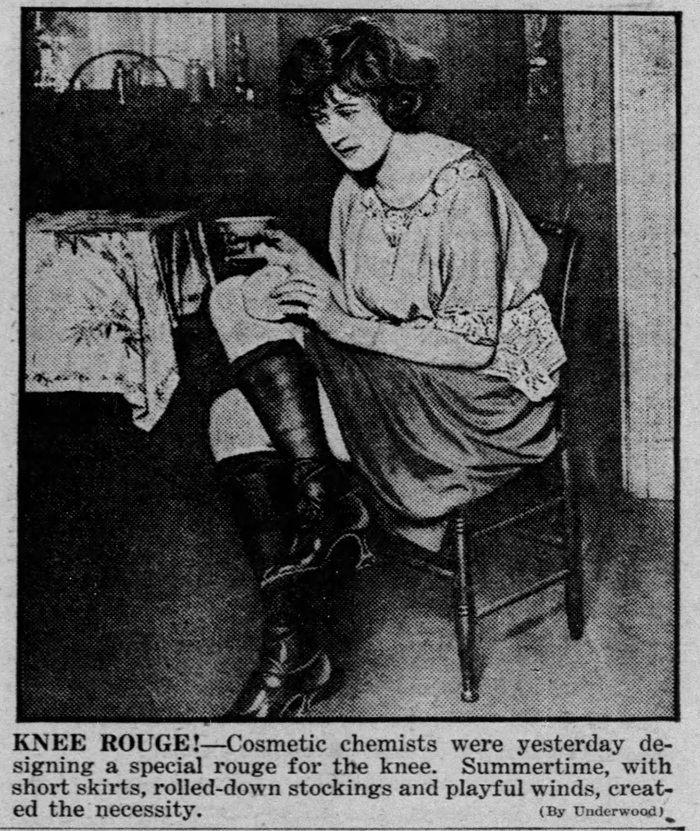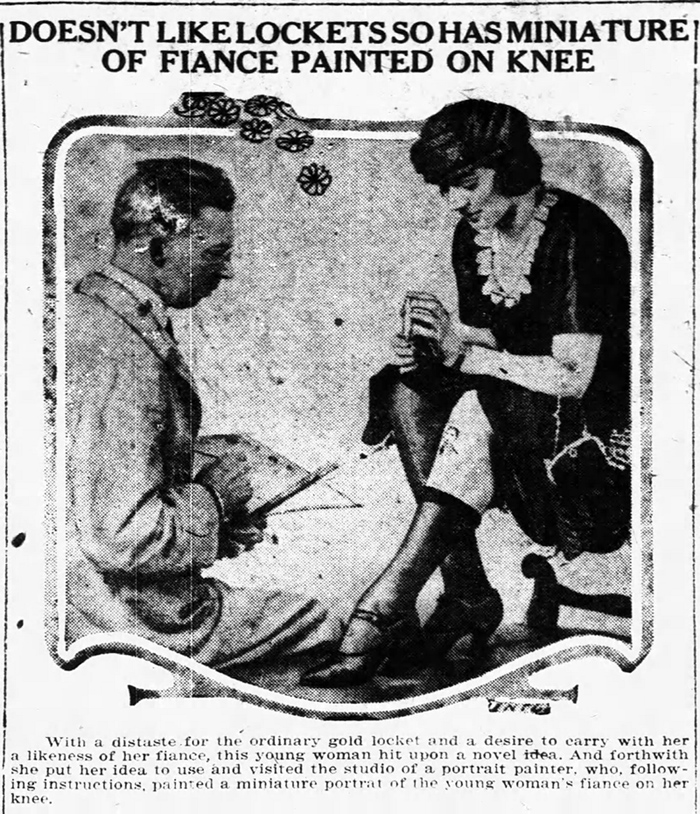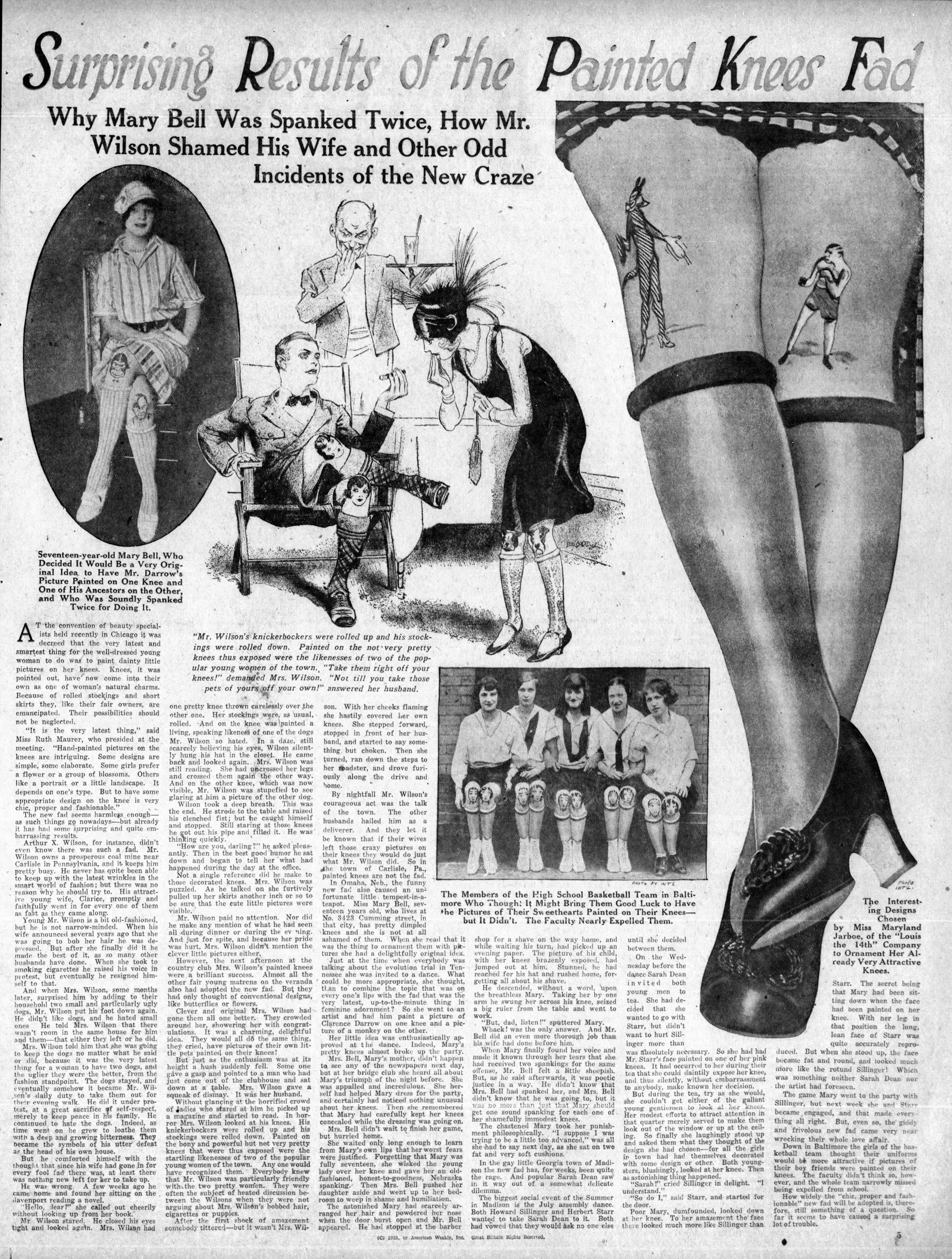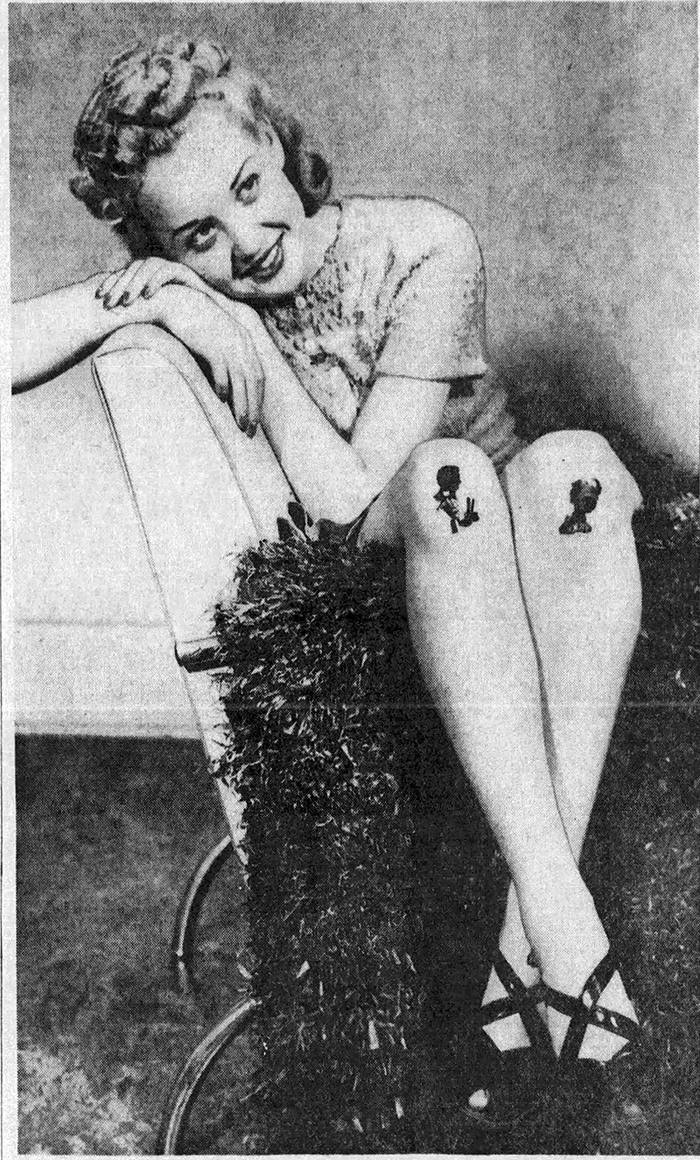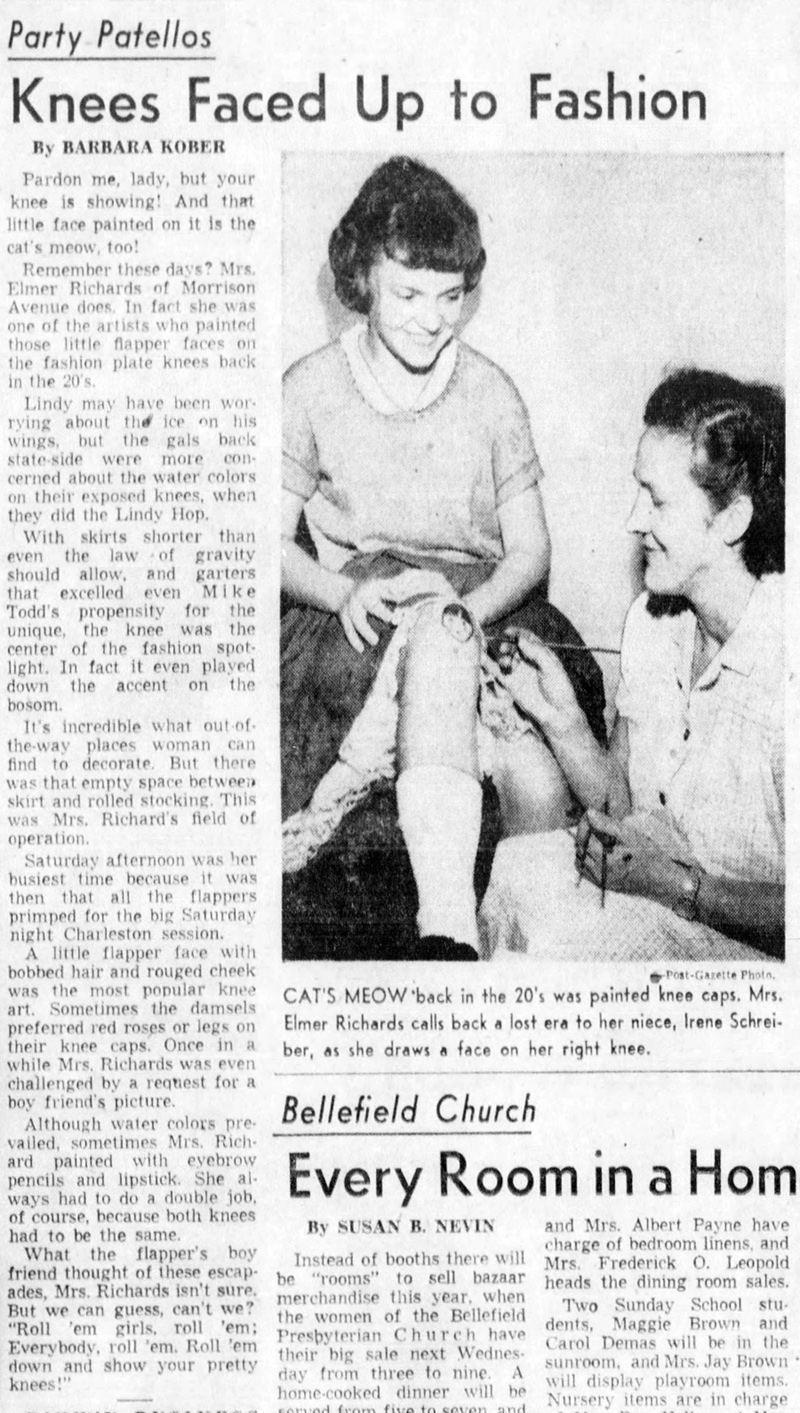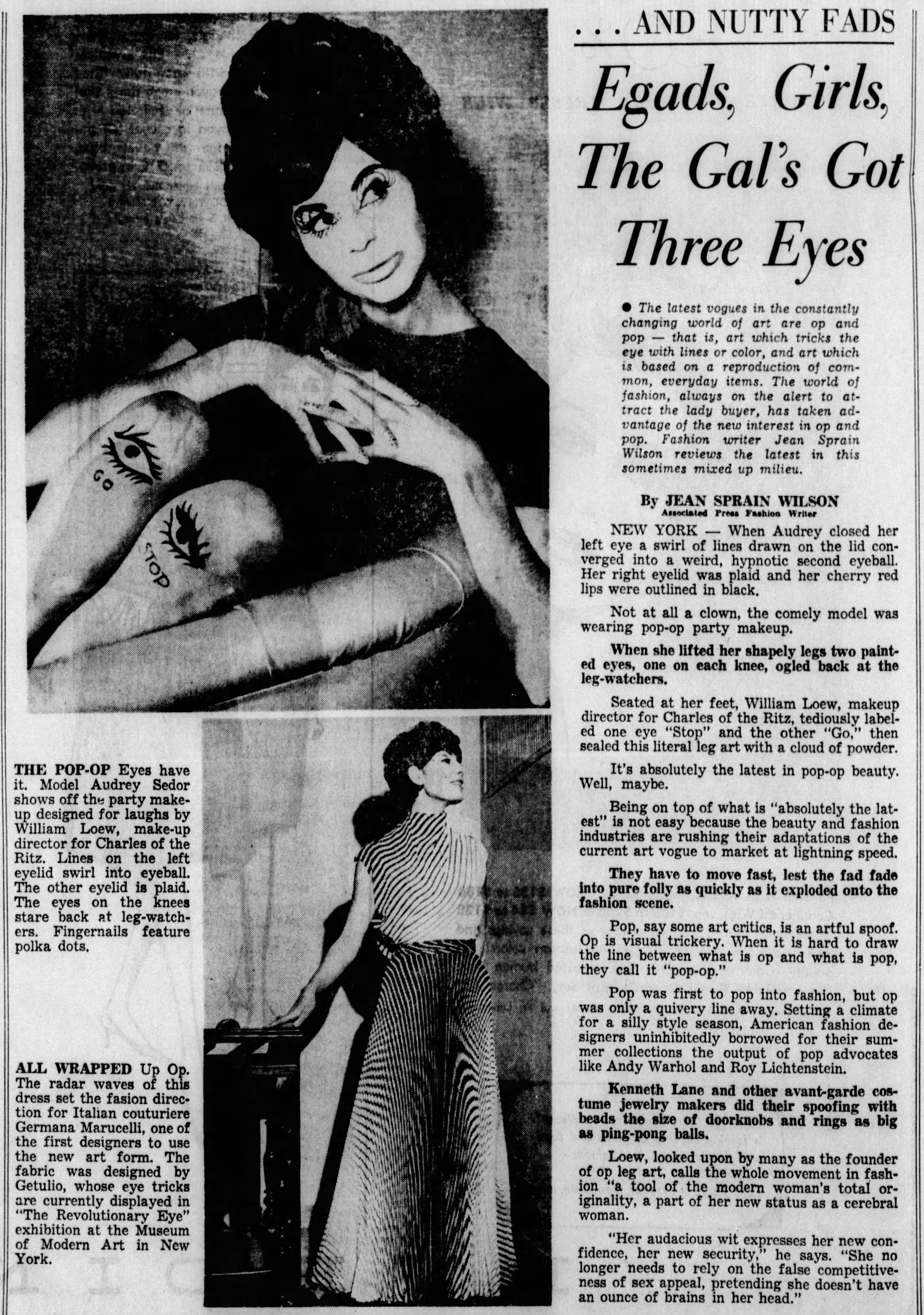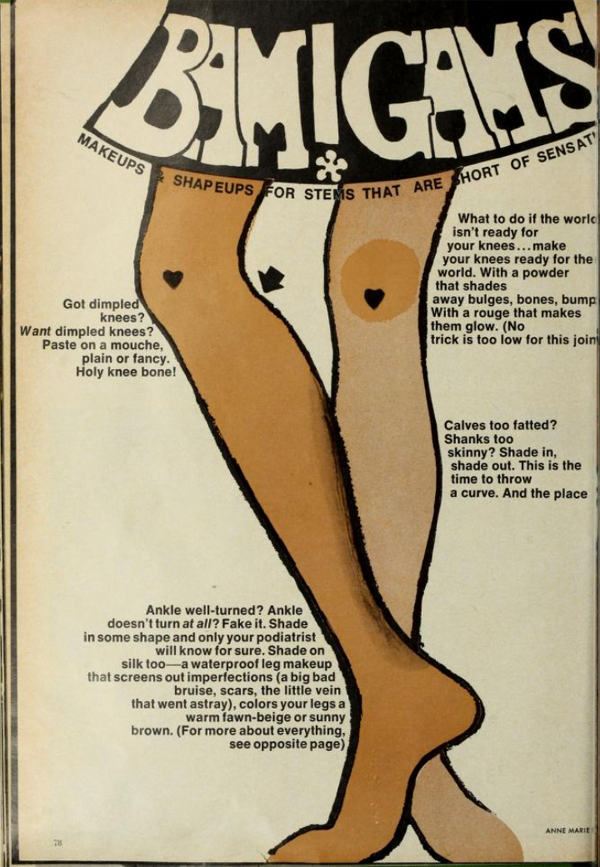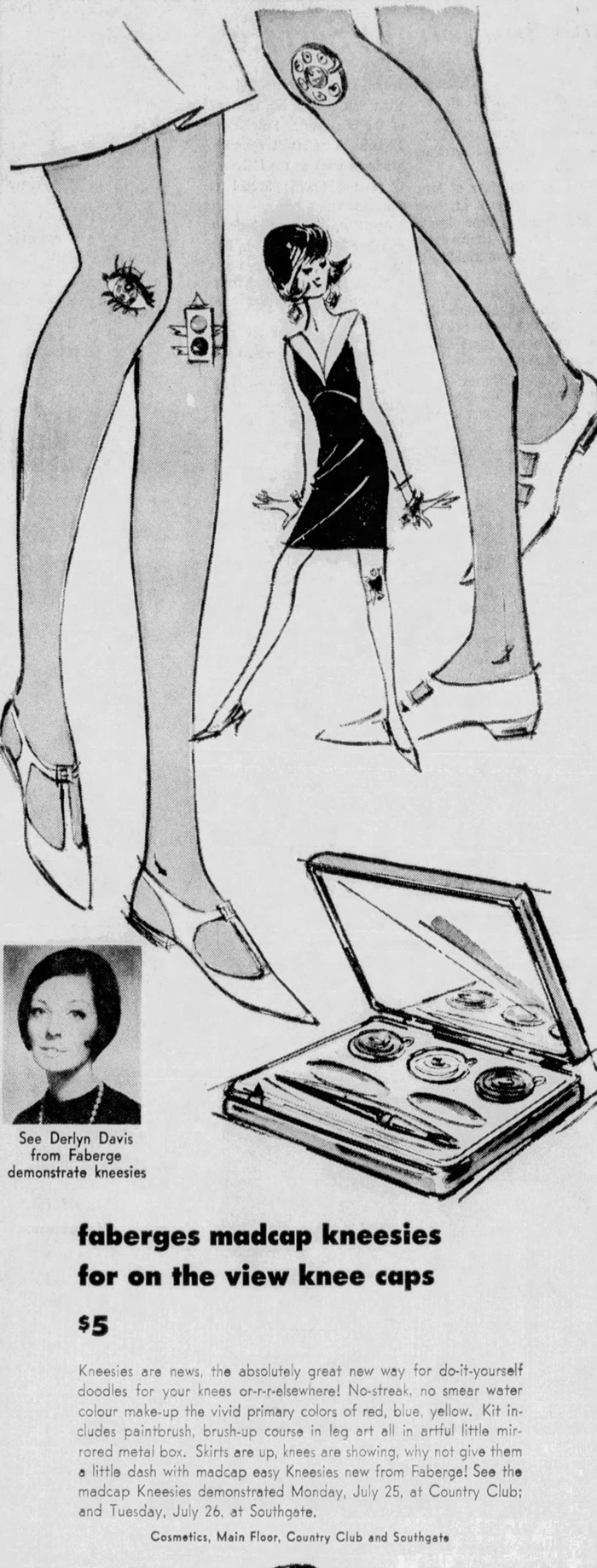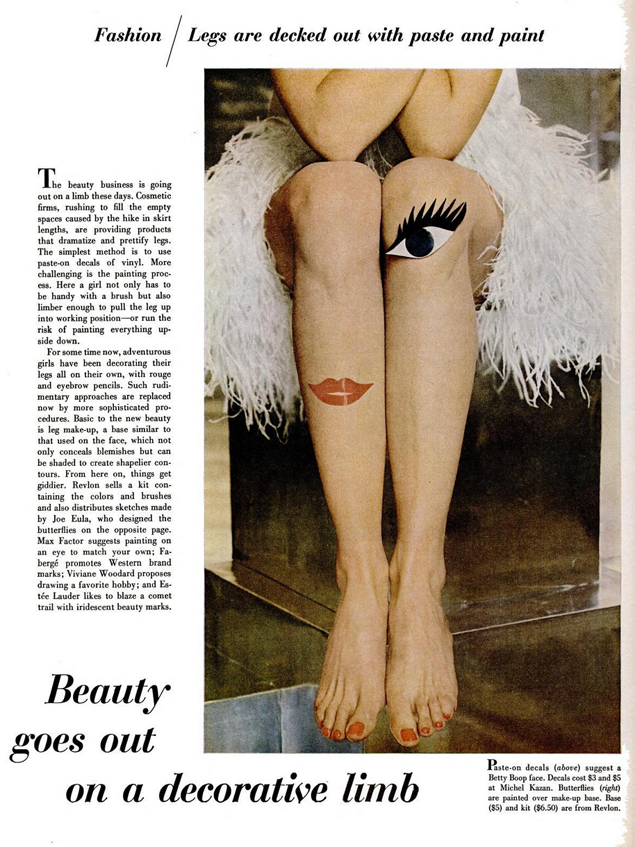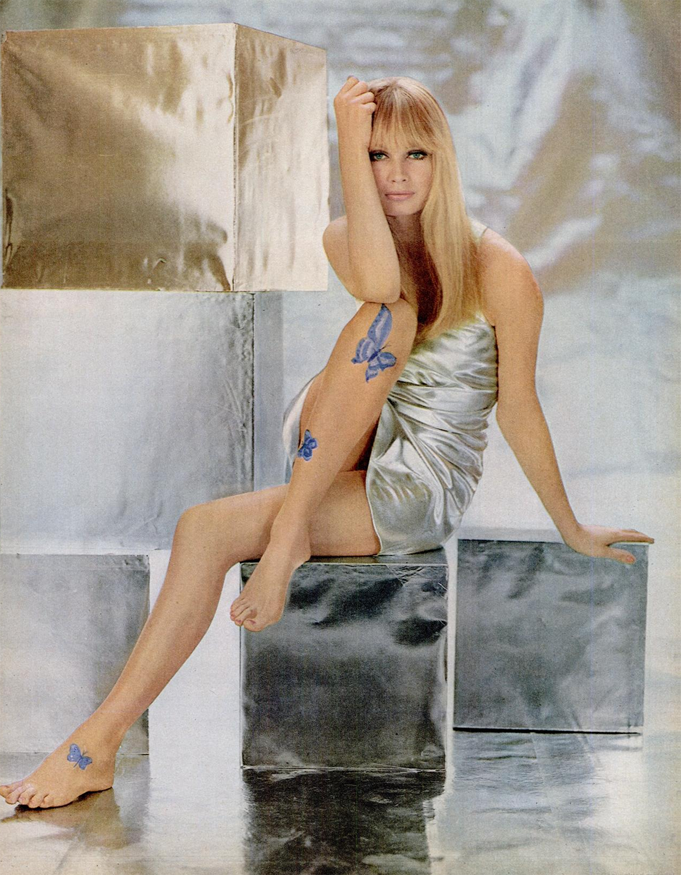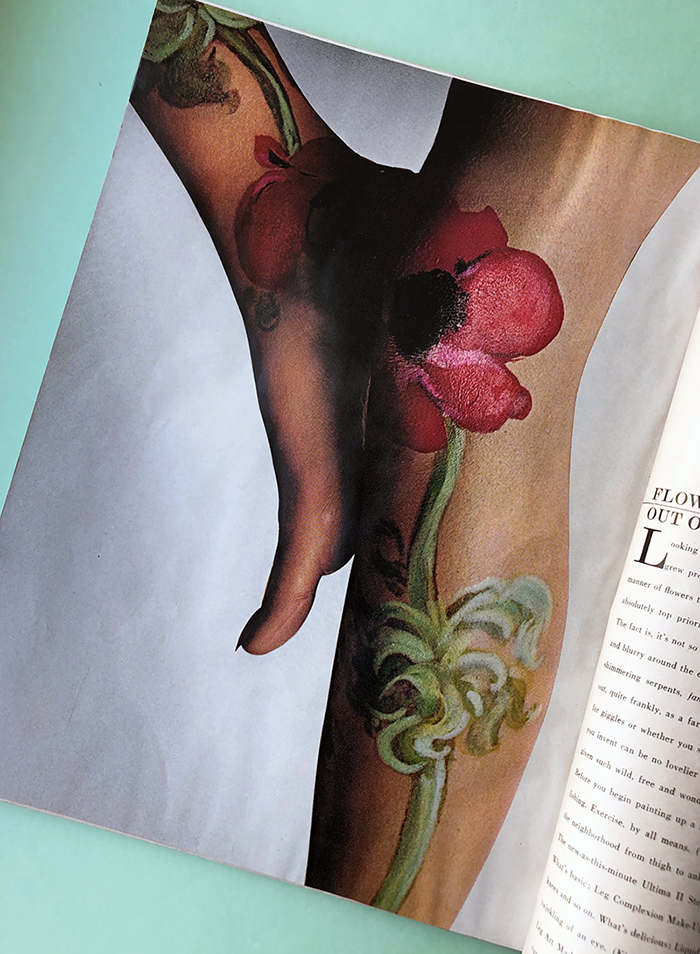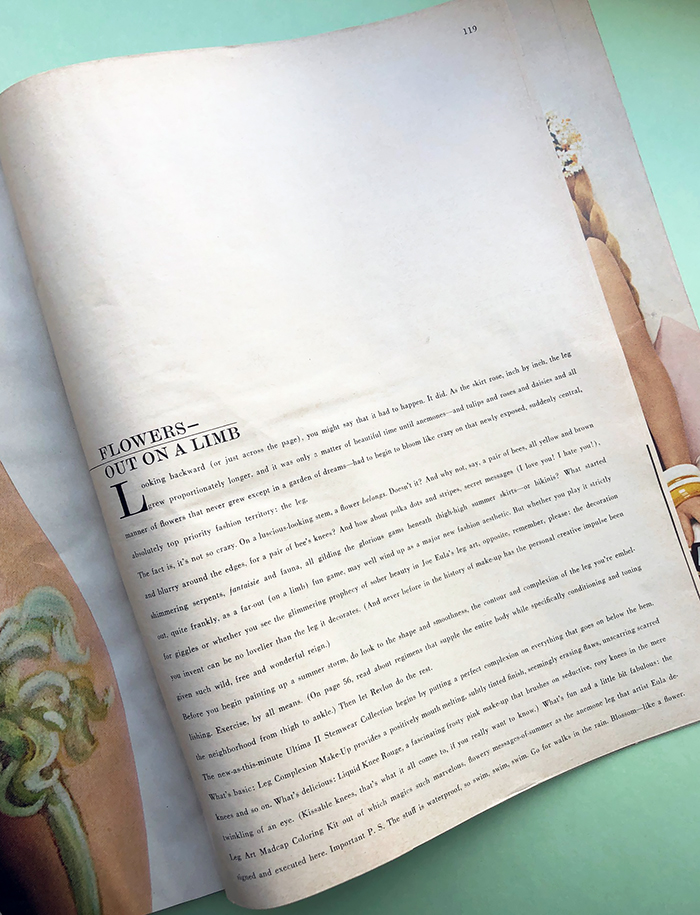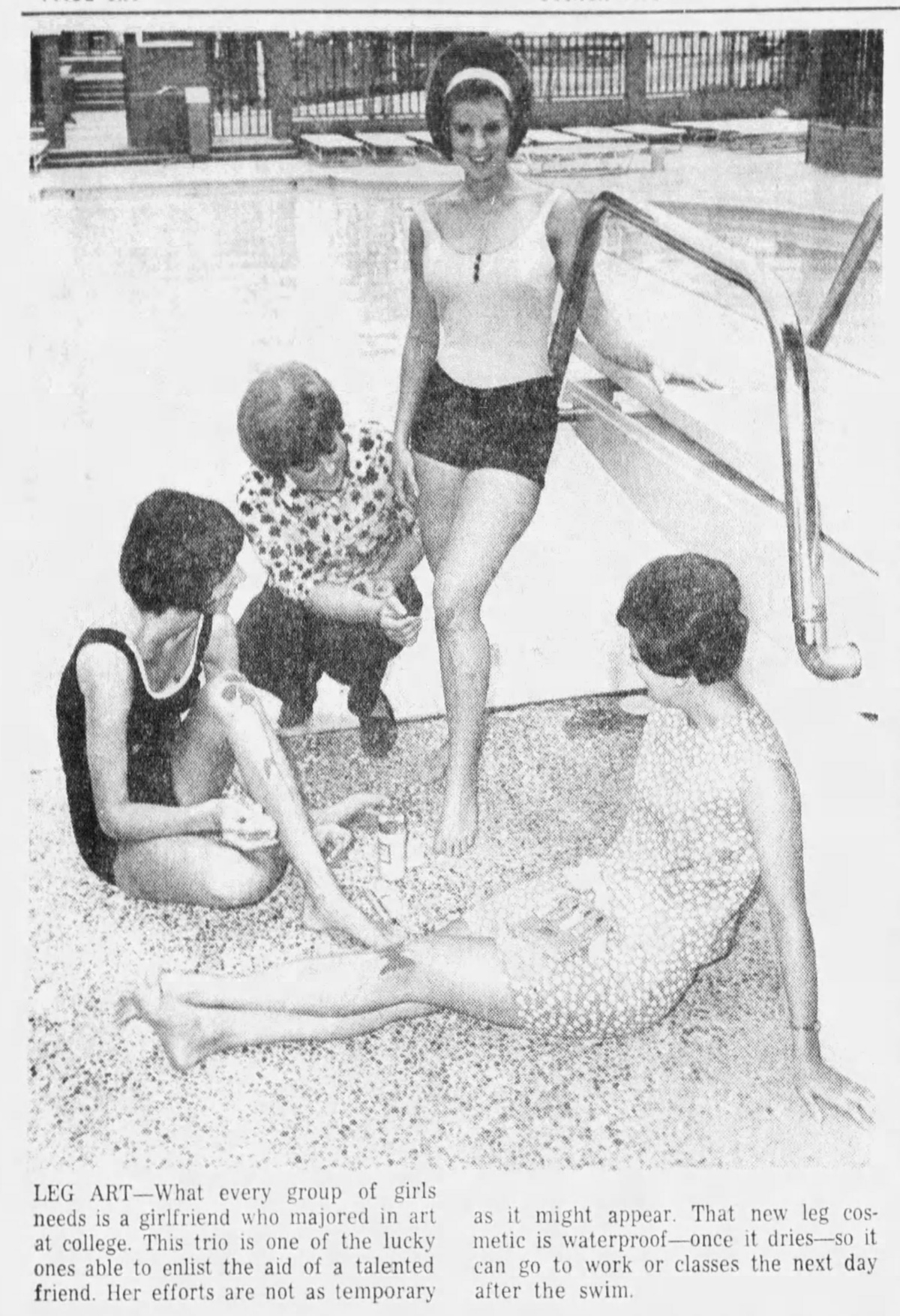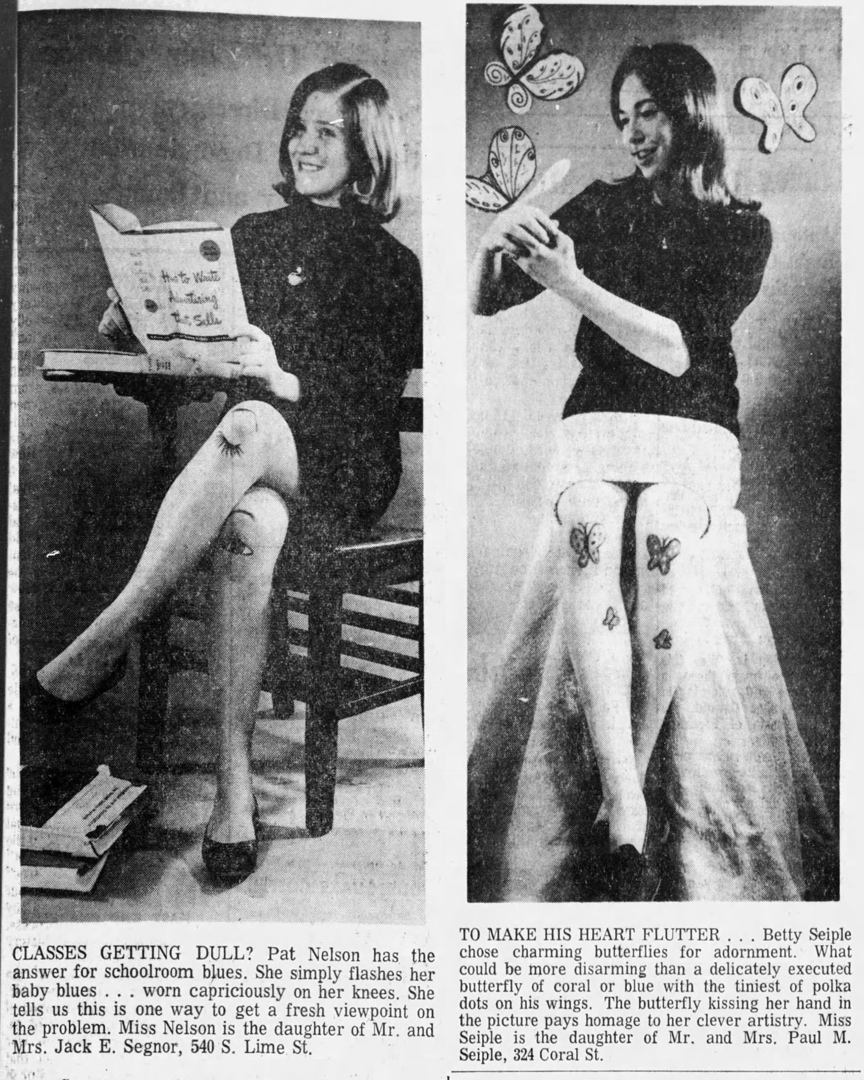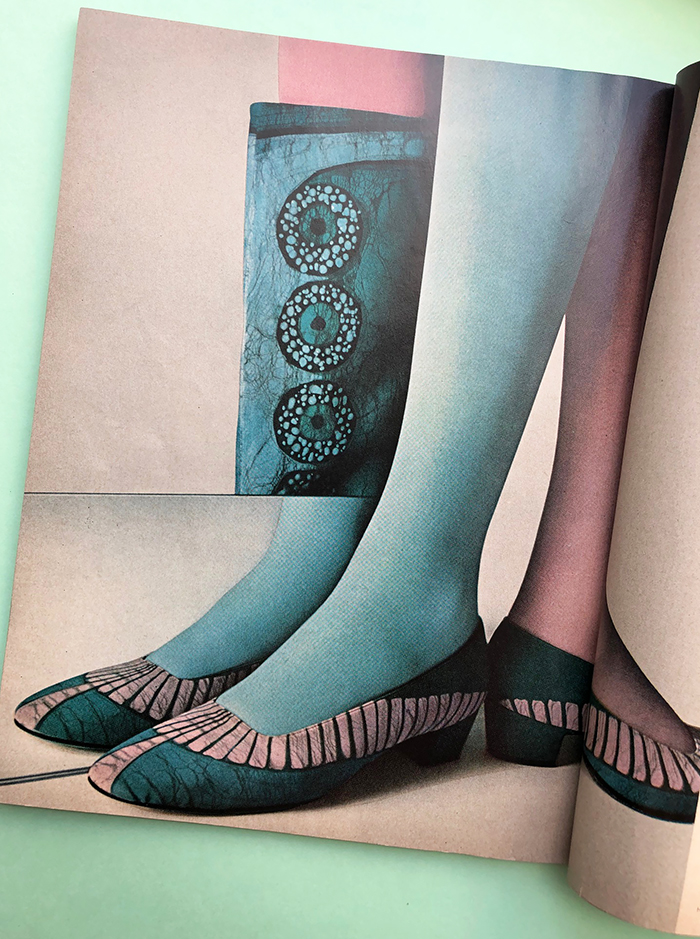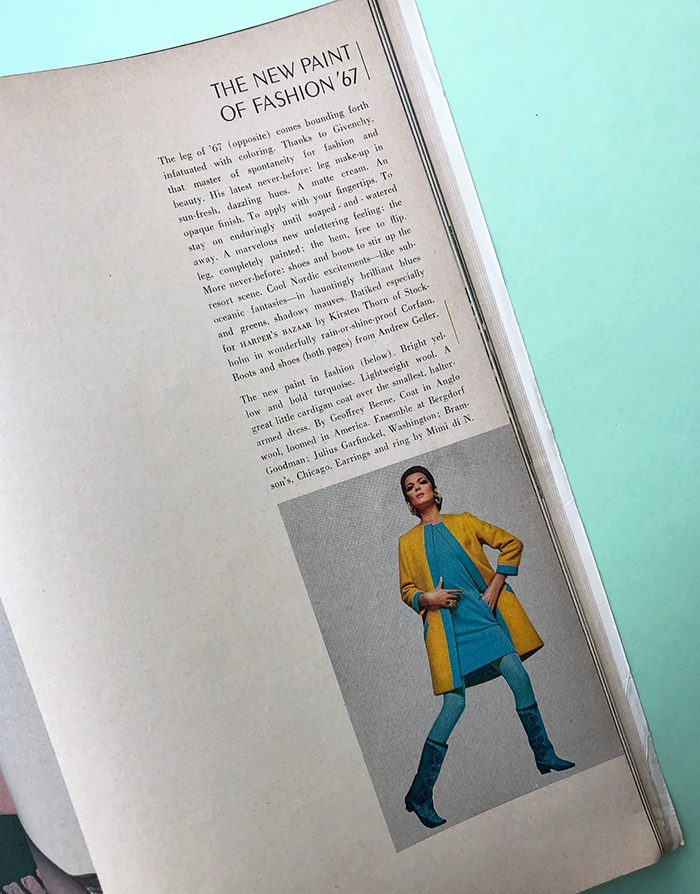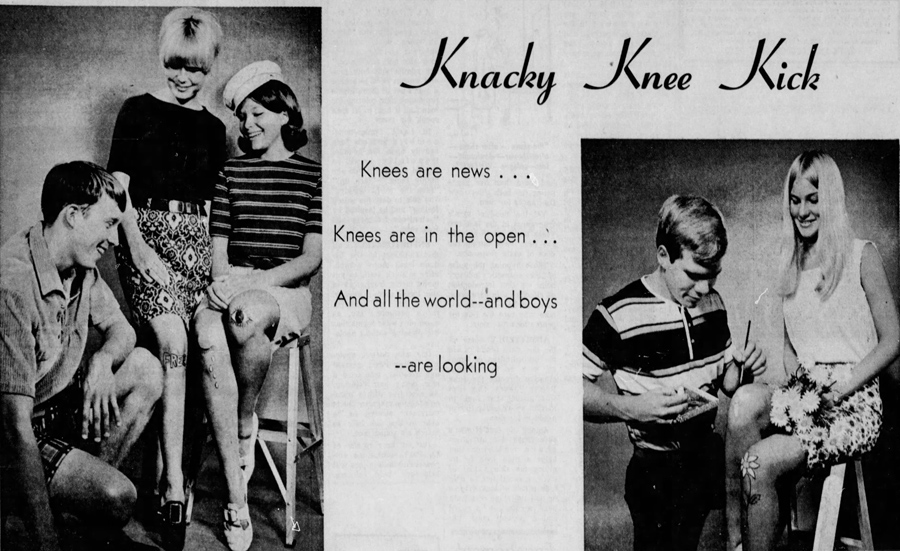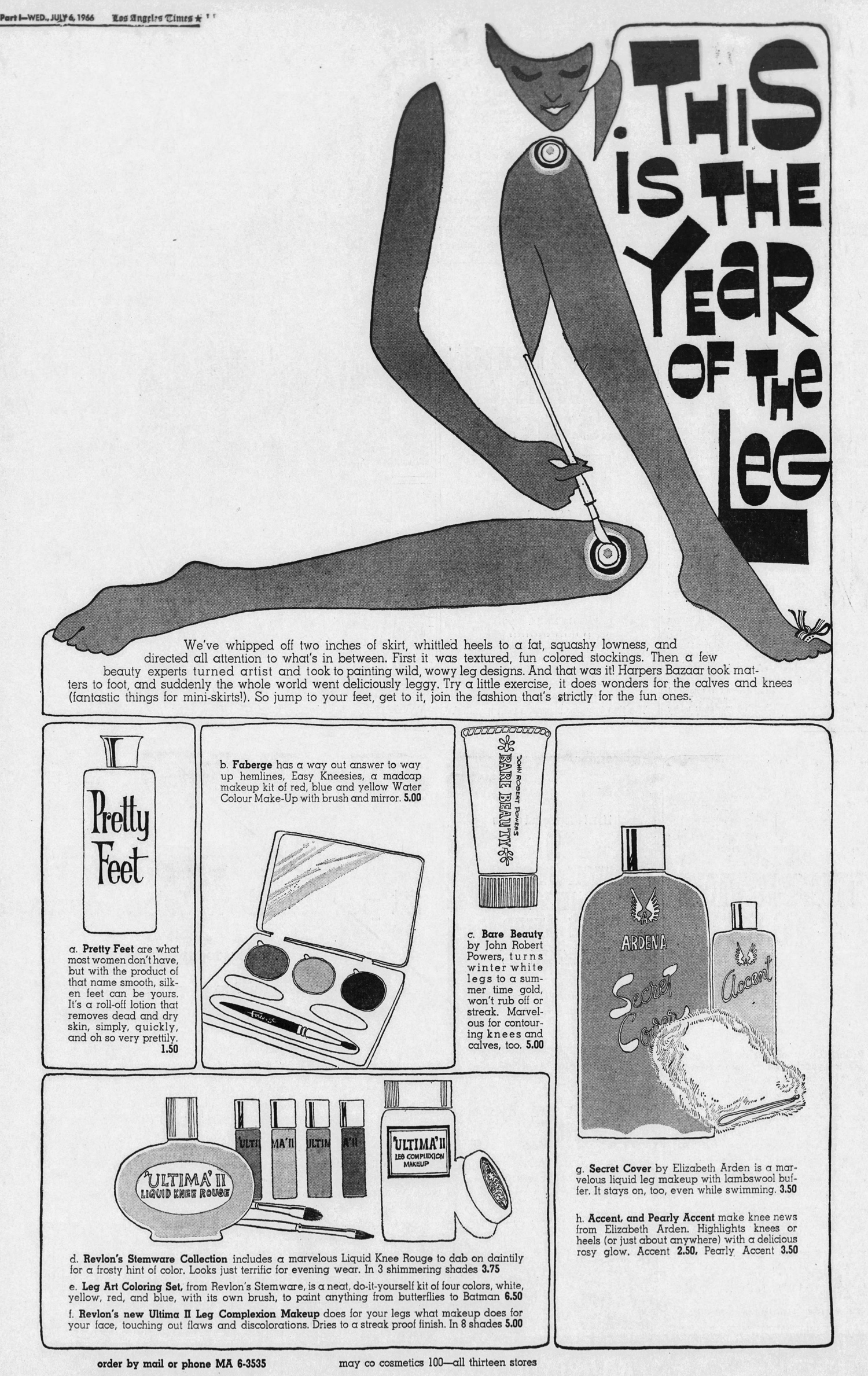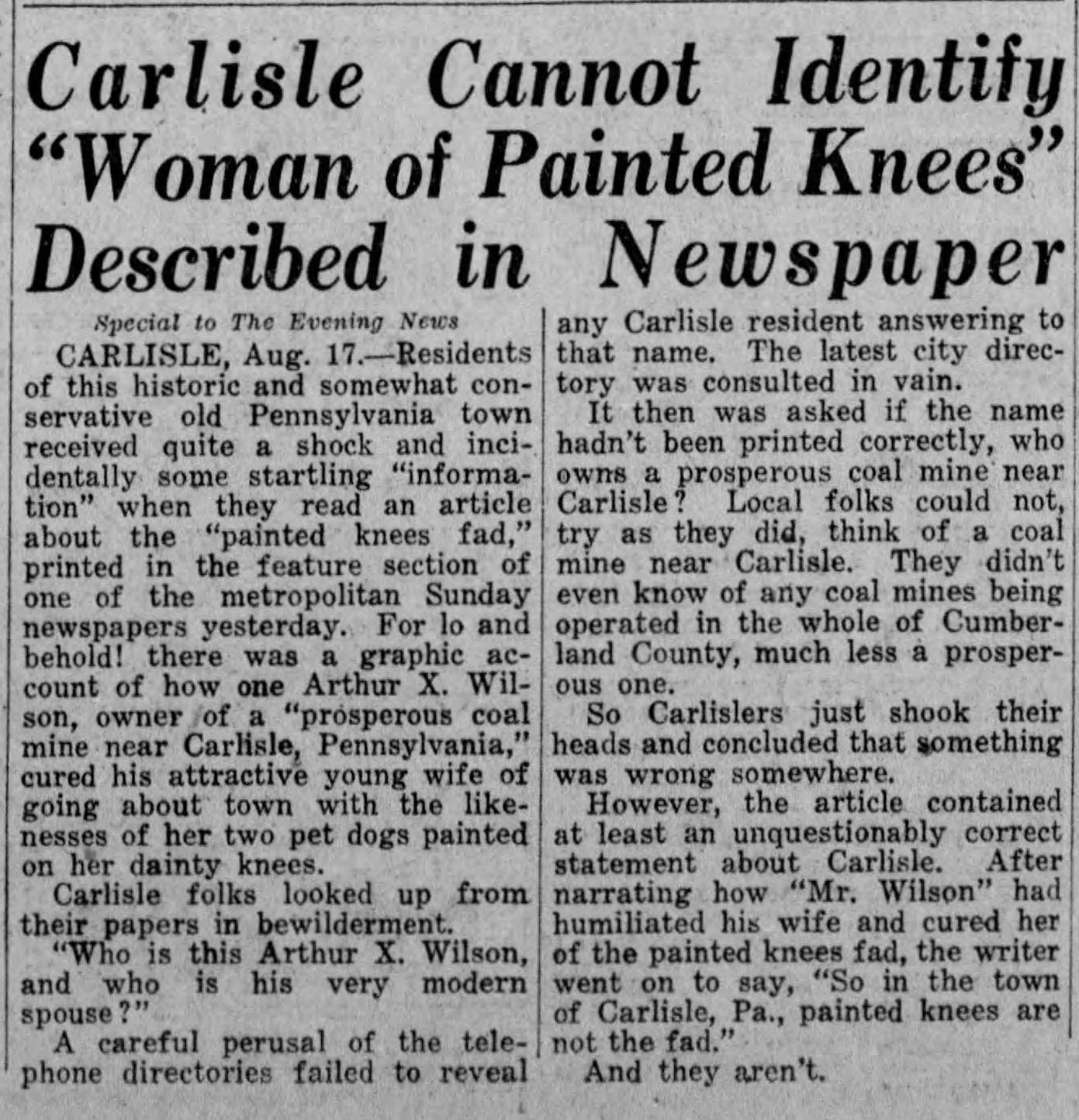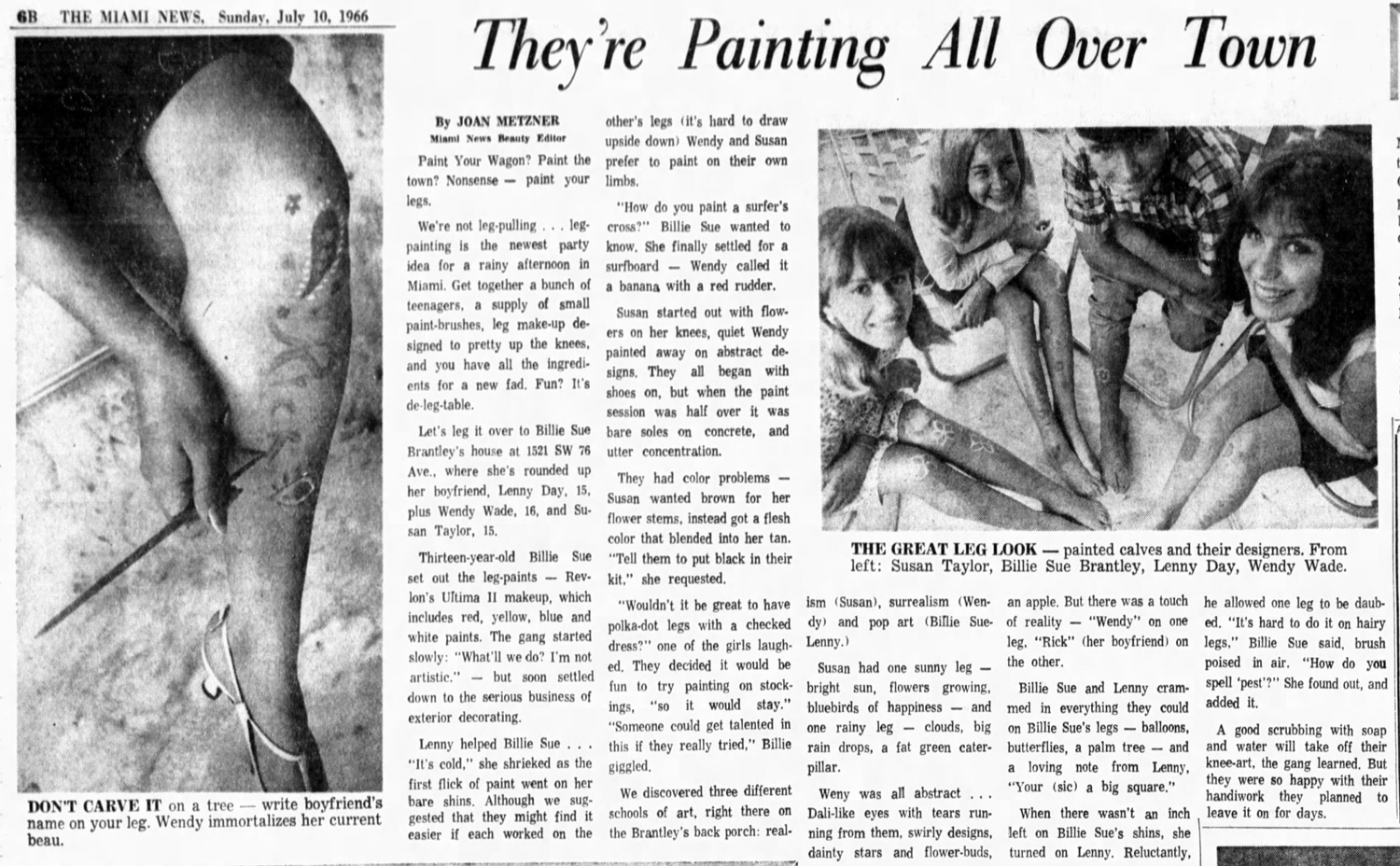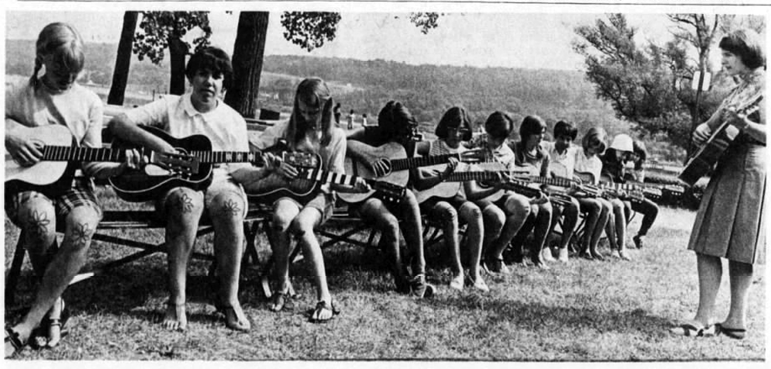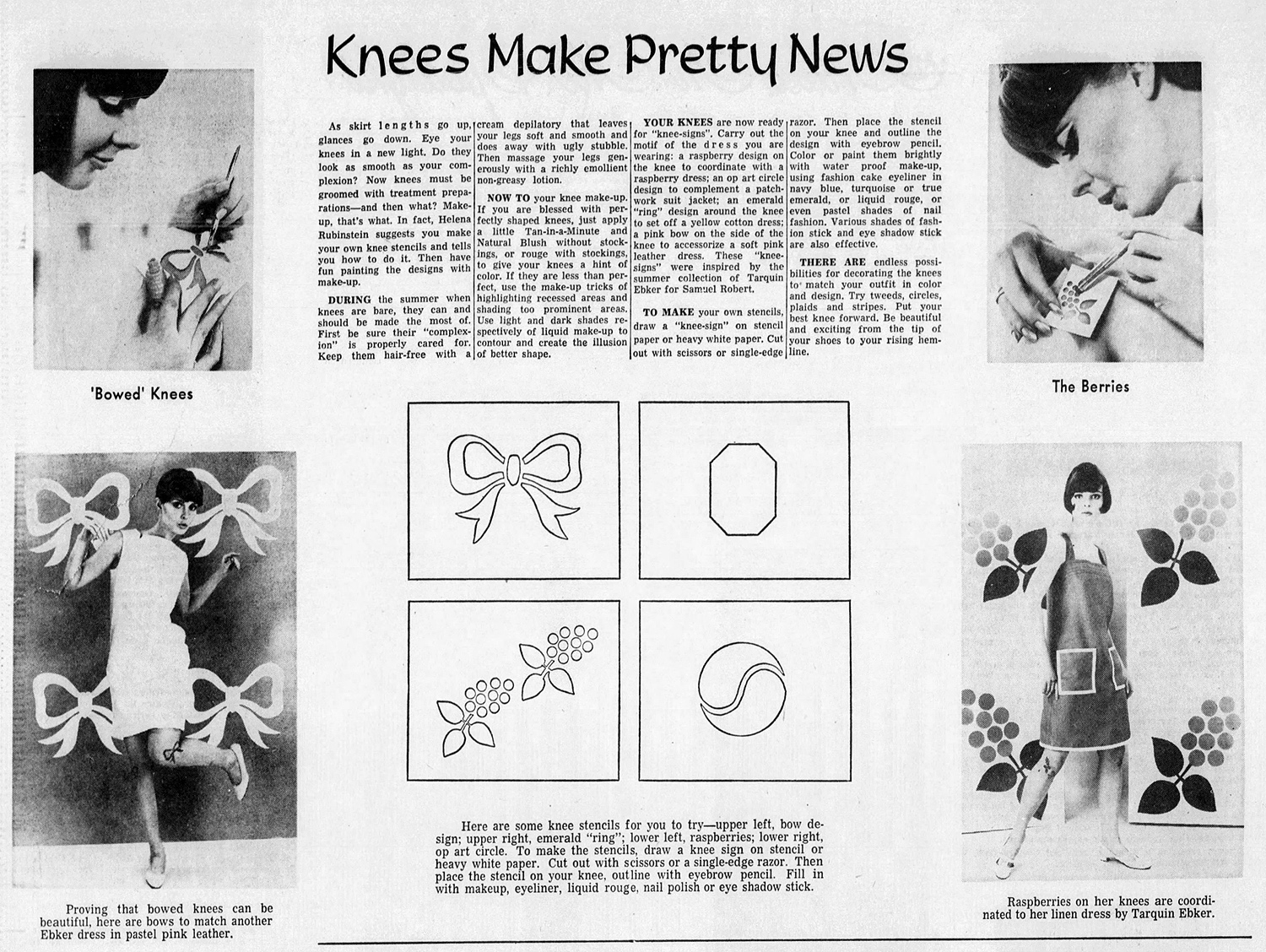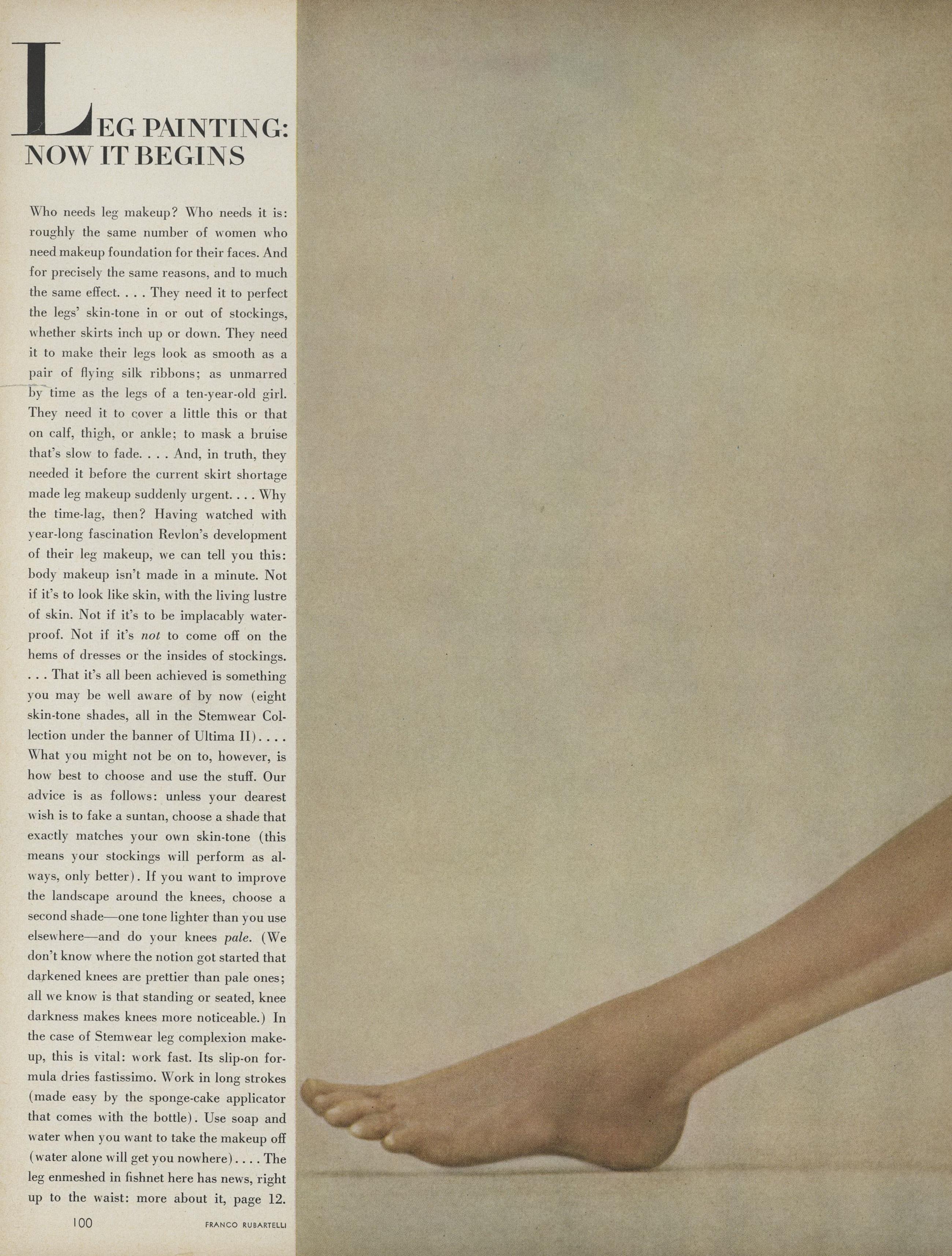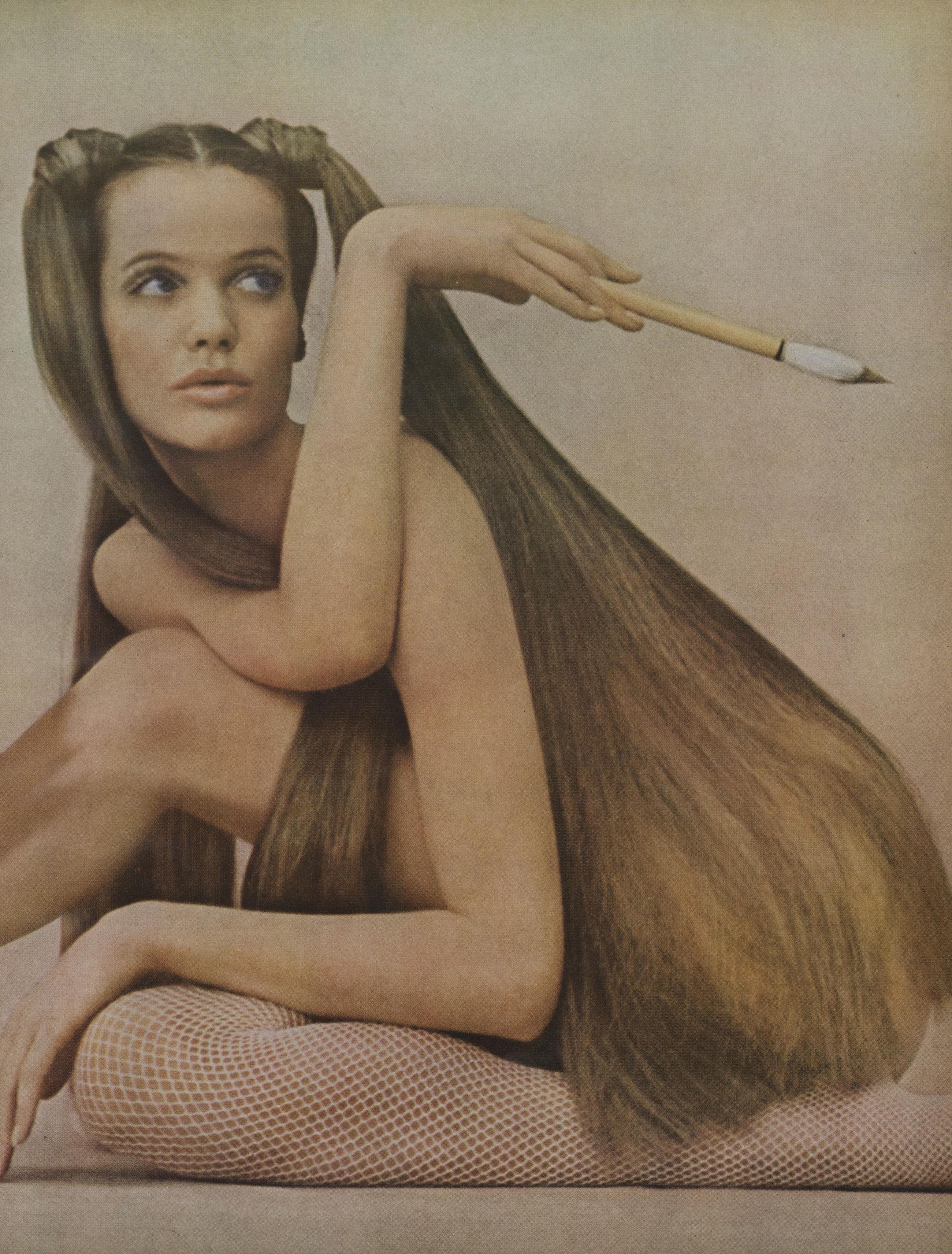Not sure how I missed Mimi Choi's fantastic makeup optical illusions on Instagram, but I'm grateful to Jen of Coffee Sundays for introducing me a few months ago. One look in particular caught my eye: Choi's hilarious "twin", Knee-Knee.
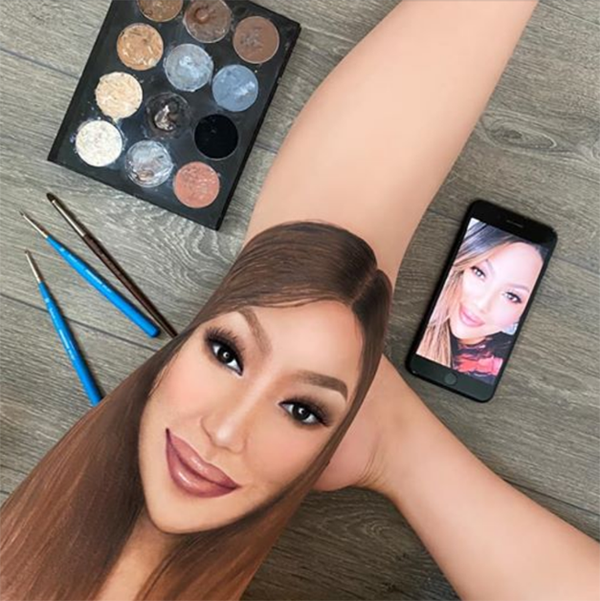
(image from @mimles)
And with that, I decided I had to find out the history of knee makeup in modern times.1 As usual this post will be heavily reliant on newspaper archives, sigh…I wish I could find more sources, especially since, as we'll see, newspapers are not always truthful. Anyway, knee makeup been around much longer than you would think. Flappers used rouge (blush) to decorate their knees, an are that was more exposed than ever despite the fact that hemlines were just below the knee (the '20s version of a miniskirt). They'd either roll their stockings down or (gasp!) forgo stockings altogether – made it much easier to do the Charleston. Adding some blush further drew attention to the knees, emphasizing the rebellious nature of the new fashion. Side note: I'm dying to figure out the shift from the word "rouge" to "blush". I'm old and even when I was a kid I remember cheek color always being referred to as blush. I wonder how and why mainstream makeup vocabulary changed. But that's a project for another day.
Knee rouging became full-on knee painting by the mid-1920s, although it had been reported in Paris in 1920. Unlike knee rouge, it doesn't seem as though makeup was actually used – at least one article discusses regular oil paints and another mentions watercolor – but the average woman as well as traditional artists engaged in the practice. The designs ranged from incredibly detailed portraits and landscapes to simple flowers and butterflies.
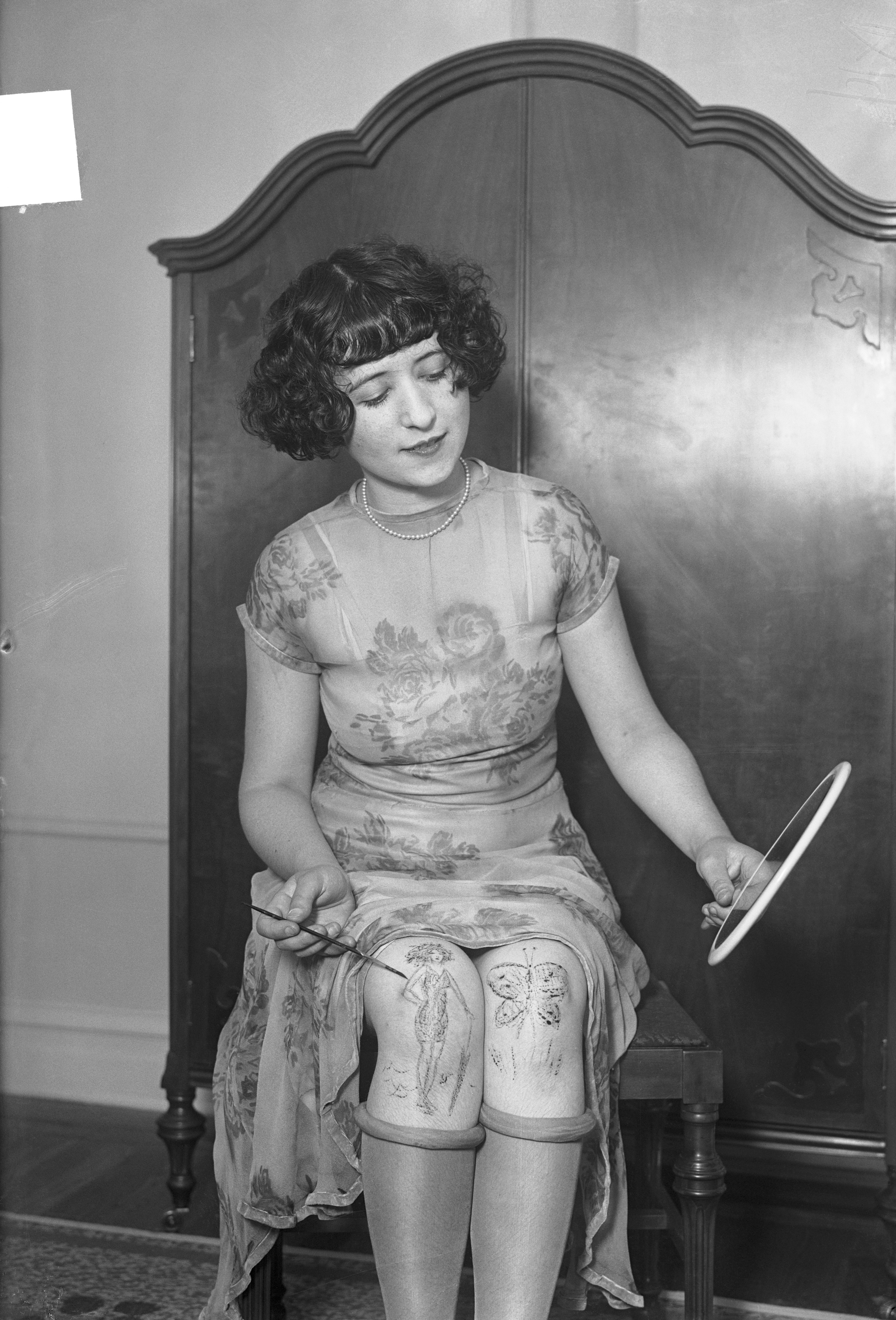
(image from livingly.com)
One could argue that knee painting was a good way to pique the interest of boys. Teenage girls would paint the initials of their boyfriends or desired boyfriends, while one woman, who wasn't keen on the idea of carrying a portrait of her fiance in a locket, had his likeness painted on her knee instead.
But like regular knee rouging, it was also a demonstration of creativity, provocation and rebellion, which led to either encouraging men to further sexualize women's bodies or a total backlash against the practice. "And, my, here comes a beauty; I watch as it walks by – a painting like that always seems to catch my eye. As one sees a comely miss with both knee-caps ablaze, studying art becomes a treat to all of us these days," a 1925 poem reads. One housewife by the name of Clarice Wilson, well aware of her husband's hatred for the new dogs she recently acquired, painted them on her knees for a passive-aggressive dig. Her husband, Arthur X. Wilson, retaliated by painting the likenesses of two of the most attractive women in town on his own knees. While adult women may have been mildly shamed for knee art, teenagers were soundly punished. Seventeen-year-old Mary Bell was spanked by both of her parents for painting Clarence Darrow and a portrait of a monkey on her kneecaps and a high school basketball team (from Baltimore!) was nearly expelled for showing school spirit via knee painting. (Click to enlarge.)
Between the 1920s and 1960s there was scant mention of knee makeup. Besides a couple of 1939 articles and a nostalgic look back in 1957, knee makeup simply wasn't on the radar.
Yes, I shamelessly stole the title of my post from this article.
But the craze for knee painting returned with a vengeance in the '60s, albeit with a slightly different flavor. Makeup artists were now finally starting to be considered "real" artists on par with traditional painters, which is reflected in their leading the way for knee makeup and the use of cosmetics rather than oil paint or watercolor applied by a regular artist. Possibly the first documented instance of knee makeup from an actual makeup artist came from William Loew, makeup director for Charles of the Ritz. In late February 1965 he painted a pair of eyes on a model's knees for a party. Touted as the "latest in pop-op beauty" and inspired by the emerging pop and optical illusion art of the time, Loew declared the pop-op movement in fashion and beauty as a step forward for women's freedom from relying solely on her looks for success. I can't help but wonder if Loew had somehow stumbled across the knee art displayed during the 1920s. In any case, I'd kill to see his work in color!
By the summer of 1965 the fad had trickled down to the masses. A suburban Pittsburgh housewife and representative for Vivianne Woodard cosmetics, Mary Metzler, took responsibility for creating the look in May 1965, admitting that she devised the idea mostly to sell more cosmetics. Over the next year the trend grew, despite Loew himself claiming it was over by late 1966. Prior to his statement, by the summer of 1966 the big makeup brands were releasing leg and knee makeup kits, with the notable exception of Elizabeth Arden, whose "face designer" Pablo "refused to have anything to do with [knee makeup]".3 Estée Lauder introduced a fairly regular line with makeup, contouring powder and highlighter, but also offered an art kit complete with stick-on jeweled beauty spots (mouches).
 (images from archive.org)
(images from archive.org)
Fabergé had their makeup director, Evan Richardson, create their "Kneesies" kit, which contained red, blue and yellow paints.
Revlon Ultima II's cleverly named Stemwear collection included both a "leg complexion" kit for those who desired basic coverage (hiding bruises and other imperfections) as well as a Leg Art kit with four colors that could be mixed: Chalk White, Chrome Yellow, Chinese Red, and Marine Blue, that came packaged in an artist's palette.
The company also enlisted fashion illustrator Joe Eula to create custom designs, which were featured in the May 20, 1966 issue of Life magazine along with the July 1966 issue of Harper's Bazaar.
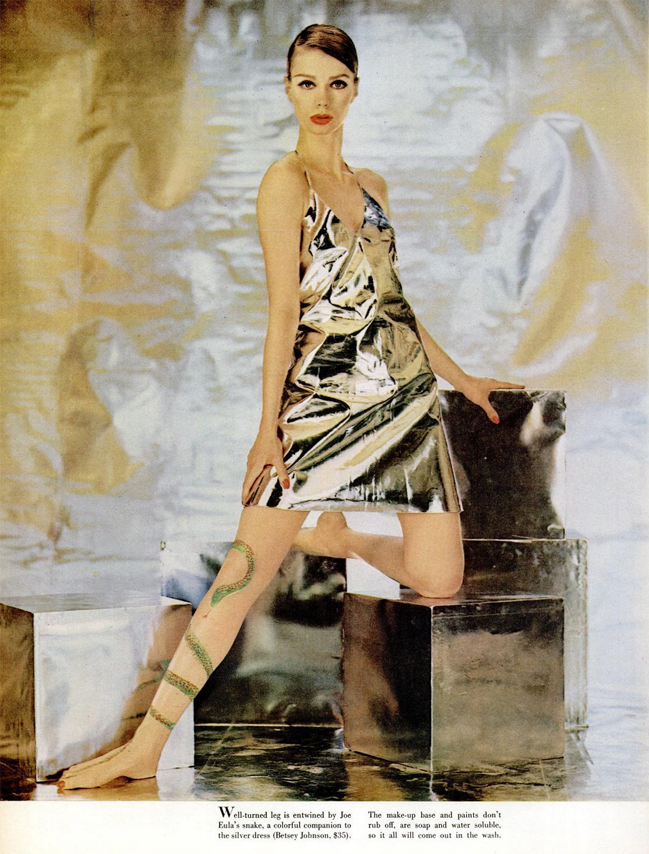 (image from books.google.com)
(image from books.google.com)
While Revlon's kit was reported to be the first leg makeup kit on the market, in July 1967 one reader of the Mercury newspaper remarked that Mary Quant, widely considered the inventor of the miniskirt, had come up with the concept of body paint first, and an indelible one at that (along with "freckle paint," which reminds me that my article on faux freckles is in dire need of updating). While I couldn't find any proof whatsoever, I have a very strong feeling that Mary Quant probably offered a fun leg makeup kit.
Anyway, as it had the previous year, knee makeup soon made its way from fashion magazines to your garden-variety middle-class teens.
Glad to see these girls were not thrown out of school or spanked by their parents.
Knee makeup art morphed into painting the entire leg by the summer of 1967, with Coty and Givenchy both releasing leg paint kits in shades meant to mimic colorful stockings.
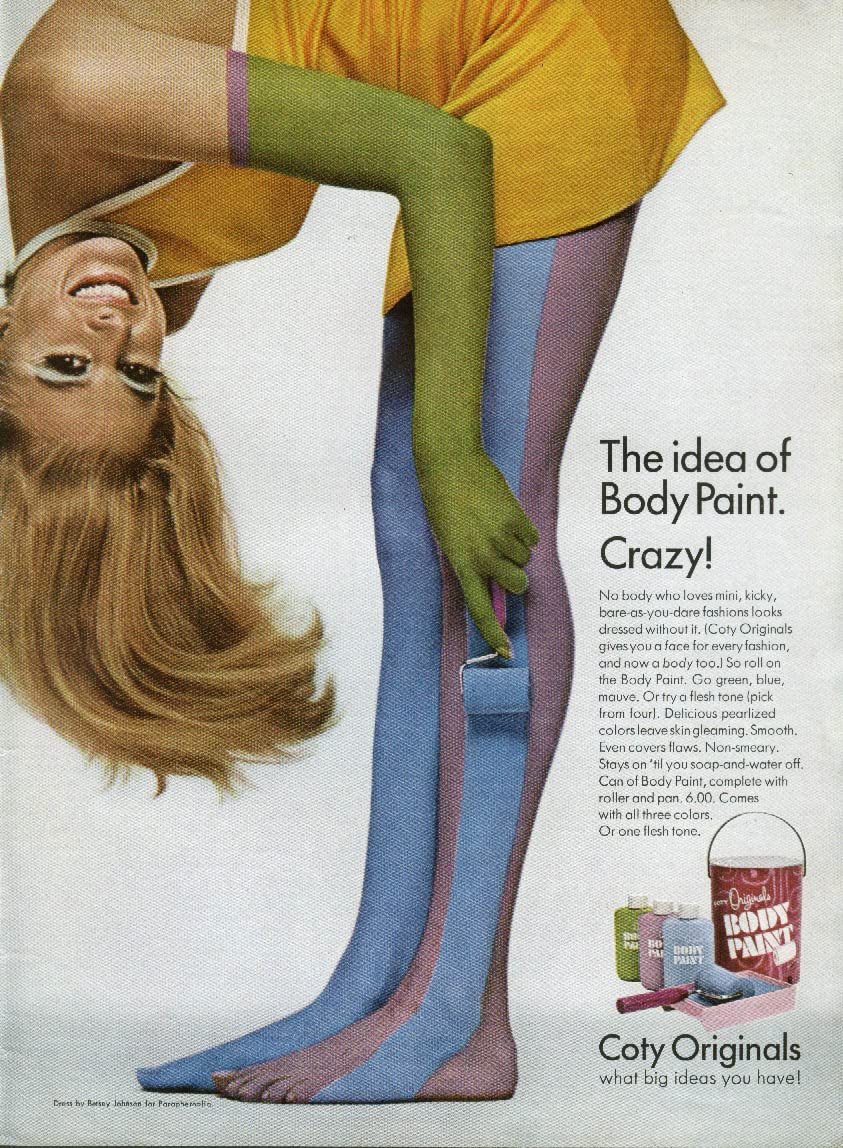
(image from amazon)
And everyone remembers the body painting popularized by hippies and mainstream shows like Laugh-In. In 1968 Tussy released a Hieroglyphics paint kit meant to be used all over the body. However, this is getting a bit off track and an entire book could be written about body paint, so I'm not going to go further with the concept now. Suffice it to say that knee makeup hit its peak in 1966 and had mostly fallen out of favor in the '70s through, well, now, partially due to the fact that pants were becoming more acceptable for women's wear. Maxi skirts and bell-bottoms took over around 1970 and lasted through the decade, while trousers became equally popular to skirts and dresses in the '80s and '90s. If body makeup were to be used artistically, all-over body paint took the place of knee makeup over time. And that's the reason Mimi Choi's art got my attention – it's rare nowadays to see only one specific part of the body adorned with makeup.
While most of the knee makeup was predicated on the ideas of creativity and self-expression, the notion of attracting boys or painting a boyfriend's name or initials was frequently noted. Girls painted "available" and "need a date?" onto their kneecaps, while Metzler, self-proclaimed inventor of the trend, "It gives [girls] something to do at the beach, but most important it's the kind of gimmick that helps them attract boys. That, after all, is the primary purpose of most cosmetics." Yikes.
Then as in the 1920s, one of the reasons for knee makeup was presumably to attract guys or express one's affection for their beau, although I don't believe it was the main reason. I tend to think it was more about having fun and allow oneself to be a bit more daring than with face makeup, since the knees, despite being on display, are not as immediately noticeable as the face. As Harper's Bazaar noted, "Never before in the history of makeup has the personal creative impulse been given such wild, free and wonderful reign."
So why did knee makeup trend in the 1920s and 1960s? Some factors for these two very different decades overlap. First, knee makeup in both eras was primarily fashion-driven.2 Leg makeup were ostensibly the result of new, seemingly shocking clothing styles for women, an example of the direct influence of fashion on makeup. Freed from the burden of stockings, either by rolling them down or skipping them entirely, 1920s women realized there was room to decorate this newly acquired space. And the latest miniskirt styles in the mid-1960s placed a bigger spotlight than ever on legs, with Harper's Bazaar declaring 1966 to be "the year of the leg".
I acknowledge makeup doesn't exist in a vacuum and that there is a definitive link between cosmetics and clothing, but generally I don't think fashion affects makeup trends as much as we think. Having said that, knee makeup seems to be a clear case of fashion dictating makeup.
The other factor at play for the knee makeup fad peaking in the 1920s and 1960s besides leg exposure in and of itself was a celebration of freedom from both an expectation of modesty and clothing that restricted movement. Not coincidentally, (White) women's rights gained significant ground in both eras, and perhaps knee painting was a byproduct of women's social advancement. As fashion historian and writer Marlen Komar points out, "Whether it was the '20s or '60s, women turned to knee painting to not only flex their creativity and have a bit of fun, but also to assert their autonomy, own their sexuality, and label themselves as a new generation of modern women. Makeup bags are often more political than we give them credit for." I'm inclined to agree for the most part. Miniskirts may not have been as liberating as history makes them out to be as they were originally intended only for the younger crowd and women today continue to get blamed for sexual assault for wearing too short a skirt, but by and large shorter silhouettes were revolutionary. Knee makeup, along with shorter hems, could be viewed as another way women were enjoying their newfound freedom.
Of course, precisely because of the rebellious and assertive nature of knee art, there were detractors in both decades as well. The loudest were those who harped on the ugliness of the knee. While fashion designers hiked up hems in the name of emancipation during the '60s, others simultaneously (and hypocritically) discussed the need to make knees less offensive via makeup rather than demanding skirts and dresses get back to a lower length. Or, you know, making pants acceptable or just letting women show their legs without feeling pressured to prettify them with makeup. Knees were apparently hideous, which is exactly why any woman donning a miniskirt was automatically declared brave. (Sort of like how we talk about celebrities going bare-faced in public now.) As Gil, makeup director for Max Factor noted in 1966, "Exposing the knee is the most daring thing a woman can do. After all, let's be clear about it. The knob is terribly ugly." Says one columnist: "One cannot help wondering why this usually rather ugly thing must at all costs be displayed. But it is never worthwhile to try to figure out fashion." Another article's headline sums it up thusly: "Glorifying the Ugly: Knees Take on Decorative Look". And going back to 1925, critics claimed that not even painting could help offset the visual offensiveness of the knee. In their view, knee art was a dubious endeavor or an entirely lost cause. "Must be quite a task to make the old joints look attractive…I don't believe that painting the knees will help them any. It would take more than paint to make the average knee worth looking at."
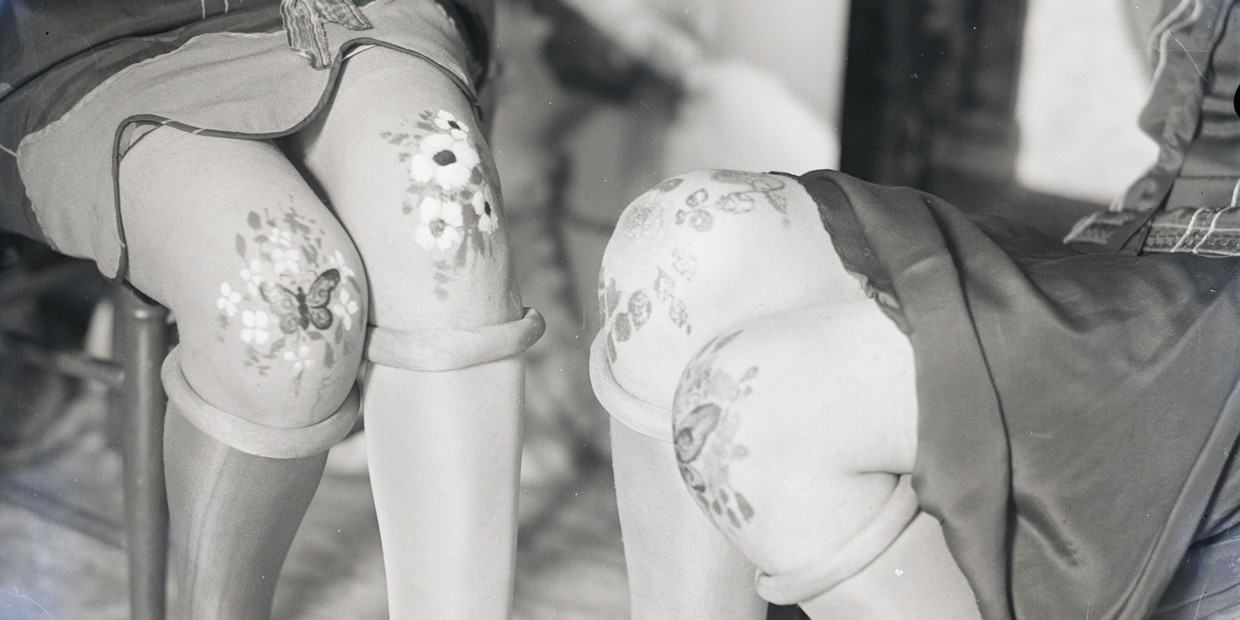 (image from livingly.com)
(image from livingly.com)
Naturally, random men had to make their opposition heard too. One Charles Denton wrote in a 1966 opinion column for the San Francisco Examiner, "Having discerned that the knee has all the esthetic charm of a pickled pig's foot, did the style setters lower the skirt back over it? (With a thigh?) They did not! Instead they started concocting cosmetics to glamorize it. Which is about as logical as shaving your beard and then putting on a phony beard…I hardly need to tell you guys where this trend is leading. Because aside from adding to the upkeep on your favorite dame, not to mention your wife, this places yet another strain on the male psyche…the next time you're pacing the floor waiting for her to get ready to go out and you holler, 'What's taking you so long?' she'll chirp back, 'Just a few more minutes, I'm doing my knees.'" Oh, poor delicate Charles with your already fragile "male psyche"! He was not concerned about the expectation that women must attempt to make their legs look more attractive given the new short styles in addition to their normal beauty regimen, but that the extra time required for them to complete their makeup routine may inconvenience him. STFU, Charles. No one asked you.
The other thing the trend had in common in 1920s and 1960s was that it's unclear how many women actually adopted it. As the very wise author of Cosmetics and Skin told me, "One swallow does not make a spring." Despite the wealth of magazine articles in the '60s and the newspaper articles in both decades, I have a feeling it was akin to Instagram (or Tiktok, shudder) "trends" where one makeup artist or influencer does something crazy and it goes viral. All the news outlets latch onto it and declare it a trend, when it fact only a handful of people tried it or even just the one person who started it. I suspect the same thing happened with knee makeup. It may have been fun at the occasional teenage party, but by and large I doubt many women were actually wearing it, at least not regularly. "This so-called painted knee fad seems to be one of those things everybody knows all about but nobody's ever seen," was a common quip in 1925. Dovetailing on the idea of backlash, one columnist by the name of Cynthia Grey stated that it was actually men who were trying to popularize knee makeup by putting it on every front page in order to make women look stupid. "It's funny how seriously men take freak styles and how ready they are to believe that women are morons…apparently for women to paint their knee is as important as a revolution in China or a monkey trial. The implication is, of course, what fools we women are!" Additionally, the spat between the Wilsons in the article shown earlier apparently never happened, because no one by the name of Arthur X. Wilson near Carlisle, PA existed.
It was a work of total fiction that also demonstrates the hostility towards the trend and men's need to keep women in their place. The feature included two somewhat true accounts4 of girls being punished for knee makeup (although now I have my doubts about the basketball team from Baltimore) but also felt it necessary to come up with a third example that was a complete fantasy, just to "prove" how idiotic women were for adopting the trend. As for the how widespread it was in the '60s, I asked my mom, who was 21 at the peak of knee makeup in 1966 and she had absolutely no recollection of seeing it in the news, let alone in real life. I understand that's purely anecdotal, but it goes to show that even young, stylish and progressive women – the key demographic – weren't necessarily adopting knee makeup. I'm also thinking some of the newspaper coverage of the trend in the '60s may have been the suggestion of editors who needed a fun story for a slow summer news day rather than teens picking it up of their own accord. (Click to enlarge.)
Finally, the fact that I've never seen any of these kits for sale or even an actual photo, only illustrations, suggests that knee makeup was not widely used.
Anyway, while knee makeup may have had a moment in the '20s and '60s, there were differences between two decades. In the 1920s, knee rouge and painting was associated primarily with flappers and other rebellious young women. In the 1960s, knee makeup did express freedom and was intended for youngsters, but it was less about mimicking or assimilating a particular group. While some fashion observers claimed that knee makeup was mostly the domain of mods, its appeal seemed to be more widespread, reaching those who simply saw it as a fun activity rather than allegiance to a certain style or outlook. Swim parties, summer camps, 4th of July were all occasions where friends could paint each other's knees – again, at least according to the local newspapers.
Plus, while most are accustomed to applying makeup on their face, painting one's knees is trickier as you have to paint upside down. Many articles noted that it was best to use the buddy system to ensure the design came out right. In this way knee makeup helped build camaraderie in a slightly different way than regular makeup play dates. In the 1920s it seemed that a lot of knee painting was done by traditional artists. Some salons were flooded for knee painting requests and felt as though the only option was to hire an outside artist on to meet the demand, so girls like Mary Bell and salon employee Mrs. Richards may have been exceptions. The shift during the '60s from hiring a painter to either a makeup artist, DIY or having a friend do the painting switched up the dynamic, as evidenced in these photos.
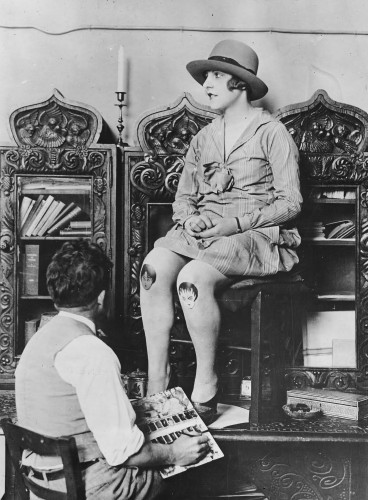
(image from marymiley.wordpress.com)
Another difference was that there more emphasis on fashion in addition to art. Besides Revlon's use of a fashion illustrator to sell their kit and the trend being spotted primarily on local fashion runways and department stores, some proponents recommending matching or coordinating one's knee makeup with clothing. Helena Rubinstein recommended making your own stencils to coordinate with any outfit. (Click to enlarge.)
A third difference is that there was more acceptance for the fad in the 1960s. The average person in the 1920s generally disapproved of knee rouge or paint; not even fashion editors and other trend-setters could sway the public's opinion. But 40 years later, as long as you were young, you could get away with miniskirts and knee makeup. I guess one could argue that's progress as compared to the 1920s stance that no woman no matter her age should have painted knees, but is it really?
As the Vogue article above notes, "[Women] need [leg makeup] to make their legs look as smooth as a pair of flying silk ribbons; as unmarred by time as those of a 10-year old girl." Another fashion editor writing for the Salt Lake Tribune in May of 1966 states that knee makeup is "FUN – if one happens to be a teen or sub-teen. BAD – if one is a minute past teen. So knack your knees only according to how many years old they are. Age is one secret they can't keep." The obsession with youth might also be a function of pandering to young people in general as the baby boomer generation became front and center.
Finally, while I have my doubts that many women actually wore knee makeup art in the 1960s, the trend – or at least the idea of it – seemed slightly more widespread than in the '20s thanks to the marketing efforts of cosmetic companies and the makeup professionals employed by them, along with distribution of these ideas to a bigger audience via the ubiquity of fashion magazines. In the 1920s there was no such thing as an artistic director for a makeup brand, and companies hadn't yet grown into multi-million dollar businesses pumping out hundreds of products. Roughly forty years had passed since makeup became regularly worn; by that point there were many more products on the market than in the '20s, so companies had to go beyond the face and invent new types of makeup. It was only a matter of time before they shifted attention away from the face to the body in the hopes of generating more revenue, and short skirts gave them the perfect opportunity. Revlon, Fabergé, et al were not going to miss their chance to capitalize on and create a false need for leg makeup kits (see also: earlobe makeup). As one journalist noted in May 1966, "Cosmetics firms are about to spring a whole raft of brand new knee makeup products and ideas. The paints and brushes, powders and creams are ready and fetchingly packaged. The ad men are set to spread the word." As for the media, yes, Harper's and Vogue existed in the 1920s, but I'm guessing their circulation was much smaller than in the '60s, not to mention the slightly newer publications that been established by that point (Mademoiselle, Glamour, Seventeen, Co-Ed, etc.) People are more susceptible to buy certain products or try new trends the more coverage they receive, especially with a makeup artist leading the way and the availability of pre-made kits. Lastly, makeup technology was allegedly improved in terms of longevity. Nearly all of the advertising for leg makeup emphasizes its long-wearing nature, a sharp contrast to the messiness of the 1940s5 and prior years.
My thoughts: this was a pretty wild trend that I would love to see again. Given the sad state of my own baggy, misshapen knees I go back and forth as to whether I'd emphasize them with makeup designs, but it would be great to see on other people. It's also one of the few trends that could work on every skin tone. Of course, so-called "flesh tone" makeup for covering varicose veins or bruises probably was not available for Black or brown skin in the '60s and certainly not prior, but the bright primary colors contained in some of the kits would suit everyone. And while short skirts on women may not be as scandalous as they were decades ago, knee makeup remains an unexpected mode of cosmetic styling and body art.
What do you think? Would you ever wear knee makeup and if so, what design would you choose? You know I'd paint portraits of Museum staff members! Or maybe a mermaid on one and a shell on the other.
1Obviously there are entire books that could be written about body paint in various cultures throughout history, so I'm focusing specifically on knee painting during the 20th century in the U.S.
2While knee painting was mostly an offshoot of fashion, there was some influence from art movements in both eras. One 1925 article notes that knee painting was taking on "Cubist lines", and another in 1966 describes one young lady who painted on a Mondrian-inspired design. Knee makeup and body painting in the '60s more generally may have also been influenced by Yves Klein's Anthropométries of 1961.
3Richard Corson, Fashions in Makeup from Ancient to Modern Times, p. 569.
4Some articles indicated that Mary Bell painted Clarence Darrow on one knee and William Jennings Bryan on the other, but the article with an actual picture shows Clarence Darrow and a monkey…so who knows what's really going on there? The photo might not have been Ms. Bell at all. In any case, multiple accounts reveal that she did paint her knees and was spanked, so at least that those parts of the story seem to be true.
5The '40s saw a spike in leg makeup due to the war. Shortages in materials meant nylon stockings weren't readily available so women painted them on, seams and all. There were entire leg makeup kits and salons had the service readily available. And while the focus wasn't the knees but the entire leg, tips for contouring those pesky knee bulges still made it into various beauty advice columns. However, there was really no fun or creativity with the leg makeup of the '40s. By most accounts it was purely to mimic the average nylon stocking – no crazy colors or designs.


